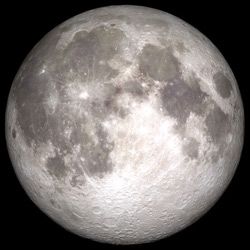
The
full moon on today will be the closest that the moon gets during its
full phase this year, so some are calling a "Supermoon." Yes, the moon
will appear larger because it's closer to us, but according to Phil
Plait, the Bad Astronomer, the effect is not as pronounced as it has
been hyped to be. The moon will appear about 1% larger than last month's
full moon, or about 10-15% larger than the smallest full moon of the
year. Here's the science behind the moon's differing appearance:
As
it happens, the Moon orbits the Earth in an ellipse, not a circle, so
the distance between us and the Moon changes all the time. When the Moon
is closest to Earth in its orbit we call it perigee, and apogee when
it’s farthest. These happen once per lunar orbit, of course, about 13
times per year each. This year, the average perigee distance is about
363,000 kilometers (225,000 miles), and the average apogee distance
about 405,000 km (251,000 miles) [Note for math and astronomy pedants:
astronomers measure distances using the centers of objects, so the
distance to the surface of the Moon from the surface of the Earth is a
bit smaller than this, by the sum of the radii of the two objects: about
8000 km.]
But those are averages; the actual numbers month by
month are all a bit different. The full Moon on June 23 will occur when
the Moon is just a hair under 357,000 km (221,300 miles) away, the
closest perigee of the year. The phase of the Moon and its distance from
Earth are not connected in any way; a full Moon can happen when the
Moon is at apogee, perigee, or any point in between. It so happens this
June 23 full Moon occurs just 20 minutes after perigee, so it really is
about as close as it can get. That’s pretty nifty timing!
So
while nothing out of the ordinary will happen during the "Supermoon,"
you should still go take a look, because the moon is always neat!
More
 The
full moon on today will be the closest that the moon gets during its
full phase this year, so some are calling a "Supermoon." Yes, the moon
will appear larger because it's closer to us, but according to Phil
Plait, the Bad Astronomer, the effect is not as pronounced as it has
been hyped to be. The moon will appear about 1% larger than last month's
full moon, or about 10-15% larger than the smallest full moon of the
year. Here's the science behind the moon's differing appearance:
The
full moon on today will be the closest that the moon gets during its
full phase this year, so some are calling a "Supermoon." Yes, the moon
will appear larger because it's closer to us, but according to Phil
Plait, the Bad Astronomer, the effect is not as pronounced as it has
been hyped to be. The moon will appear about 1% larger than last month's
full moon, or about 10-15% larger than the smallest full moon of the
year. Here's the science behind the moon's differing appearance:
No comments:
Post a Comment